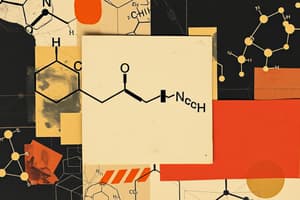Podcast
Questions and Answers
What determines the suffix of an organic compound's name?
What determines the suffix of an organic compound's name?
- The highest priority functional group present in the molecule (correct)
- The type of alkyl substituents attached to the main chain
- The alphabetical order of substituents in the compound
- The total number of carbon atoms in the chain
When numbering the parent chain of an organic compound, what should be prioritized?
When numbering the parent chain of an organic compound, what should be prioritized?
- Starting from the end nearest to a substituent or functional group (correct)
- Starting from the end with the highest number of carbon atoms
- Assigning the lowest possible numbers to the carbon atoms
- Focusing solely on the longest carbon chain without considering substituents
What prefixes are used to indicate multiple substituents of the same kind in an organic compound?
What prefixes are used to indicate multiple substituents of the same kind in an organic compound?
- Meta-, para-, ortho-
- Mono-, di-, tri-, tetra- (correct)
- Alkyl-, aryl-, -oic acid
- Cyclic-, poly-, iso-
Which of the following is an example of a functional group in organic chemistry?
Which of the following is an example of a functional group in organic chemistry?
In naming an organic compound, how should different parts of the name be organized?
In naming an organic compound, how should different parts of the name be organized?
What is the correct general formula for alkenes?
What is the correct general formula for alkenes?
Which of the following functional groups is characteristic of alcohols?
Which of the following functional groups is characteristic of alcohols?
Which organic compound is commonly used in the production of soaps?
Which organic compound is commonly used in the production of soaps?
What suffix is used for naming ketones?
What suffix is used for naming ketones?
What does the prefix 'cyclo-' indicate in organic nomenclature?
What does the prefix 'cyclo-' indicate in organic nomenclature?
Which of the following is not classified as a halogenated compound?
Which of the following is not classified as a halogenated compound?
How are substituents described in the nomenclature of organic compounds?
How are substituents described in the nomenclature of organic compounds?
Which type of organic compound does not have a functional group?
Which type of organic compound does not have a functional group?
Which type of organic compound contains only single bonds?
Which type of organic compound contains only single bonds?
Which functional group is characteristic of alcohols?
Which functional group is characteristic of alcohols?
Which of the following compounds is classified as an aromatic compound?
Which of the following compounds is classified as an aromatic compound?
An organic compound that contains a carboxyl group (-COOH) is classified as what?
An organic compound that contains a carboxyl group (-COOH) is classified as what?
What type of hydrocarbon contains only carbon and hydrogen atoms without any functional groups?
What type of hydrocarbon contains only carbon and hydrogen atoms without any functional groups?
Which classification of organic compounds features a carbon skeleton arranged in a ring structure?
Which classification of organic compounds features a carbon skeleton arranged in a ring structure?
Which type of reaction typically involves the conversion of an alcohol to an ester?
Which type of reaction typically involves the conversion of an alcohol to an ester?
What is the primary characteristic that differentiates ketones from aldehydes?
What is the primary characteristic that differentiates ketones from aldehydes?
Flashcards are hidden until you start studying
Study Notes
Basics of Organic Chemistry
- Organic chemistry studies the structure, properties, and reactions of organic molecules.
- Organic molecules contain carbon atoms covalently linked with hydrogen, oxygen, or nitrogen atoms.
- Carbon-carbon or carbon-hydrogen bonds in general define organic compounds, but some exceptions exist: carbonates, cyanides, and CO2.
- Aliphatic compounds have open chains, branched chains, or unbranched chains. These include alkanes, alkenes, alkynes, and their derivatives.
- Saturated Aliphatic Compounds contain only single bonds (e.g., alkanes).
- Unsaturated Aliphatic Compounds contain double or triple bonds (e.g., alkenes, alkynes).
- Alicyclic compounds have carbon atoms arranged in rings. (e.g., cycloalkanes).
- Aromatic compounds have a ring with alternating single and double bonds.
- Hydrocarbons contain only carbon and hydrogen. Examples include alkanes, alkenes, alkynes, and aromatic hydrocarbons.
Functional Groups
- Functional groups are specific collections of atoms that react in predictable ways.
- Examples include: hydroxyl (-OH), carboxyl (-COOH), aldehyde (-CHO), ketone (C=O), amine (-NH2), and ether (R-O-R).
- Each functional group has a unique structure and affects the molecule.
- Alkanes are the only class without a functional group. Alkenes double bond acts as the functional group.
Naming Organic Compounds
- The IUPAC rules are used for naming organic compounds.
- The base name relates to the number of carbon atoms in the main chain/parent chain which is the longest continuous carbon chain.
- The suffix reflects the functional group.
- Substituents are groups attached to the parent chain.
- In cyclic hydrocarbons, the prefix cyclo- is added before the base name (e.g., cyclohexane).
Naming Organic Compounds Steps
- Identify the Parent Chain: Determine the longest continuous chain in the molecule.
- Number the Parent Chain: Number carbons starting from the end closest to a substituent, resulting in the lowest possible numbers for substituents.
- Naming Substituents: Idenfy substituents, like alkyl groups or functional groups (e.g., -OH, -C=O).
- Use prefixes (di-, tri-, tetra-) for multiple of the same substituent.
- Assigning Locants: Use numbers to indicate the positions of substituents on the main chain.
- Assign the lowest possible numbers, considering alphabetical order for multiple groups.
- Naming Functional Groups: Identify and name the main functional group with highest priority. This determines the suffix of the compound's name.
- "-ol" for alcohols, "-one" for ketones, "-oic acid" for carboxylic acid.
- Putting It All Together: Combine names of the parent chain, substituents and functional group, separated by hyphens and commas when necessary.
Applications of Organic Chemicals
- Used in the production of medicine, soaps, shampoos, powders, and perfumes.
- Various fuels like natural gas and petroleum are organic compounds.
- Many fabrics used for clothing are made from organic compounds.
Types of Organic Reactions
- Addition Reactions: Atoms are added to a molecule, often across a double or triple bond.
- Substitution Reactions: One atom or group is replaced by another.
- Elimination Reactions: Atoms or groups are removed from a molecule, often forming a double or triple bond.
- Condensation Reactions: Two molecules combine, eliminating a small molecule like water.
- Oxidation-Reduction Reactions: Involve the transfer of electrons, where one molecule loses electrons (oxidation) and another gains electrons (reduction).
Hybridization of the Carbon Atom and Shapes of Organic Molecules
- Hybridization explains the bonding in organic compounds.
- sp3 Hybridization: Carbon combines one 2s and three 2p orbitals forming four equivalent sp3 orbitals. This leads to a tetrahedral geometry with bond angles of 109.5 degrees. (e.g., methane)
- sp2 Hybridization: Carbon combines one 2s and two 2p orbitals, forming three equivalent sp2 orbitals. This leads to a planar geometry with bond angles of 120 degrees. (e.g., ethene)
- sp Hybridization: Carbon combines one 2s and one 2p orbital, forming two equivalent sp orbitals. This leads to a linear geometry with bond angles of 180 degrees. (e.g., ethyne)
Studying That Suits You
Use AI to generate personalized quizzes and flashcards to suit your learning preferences.




